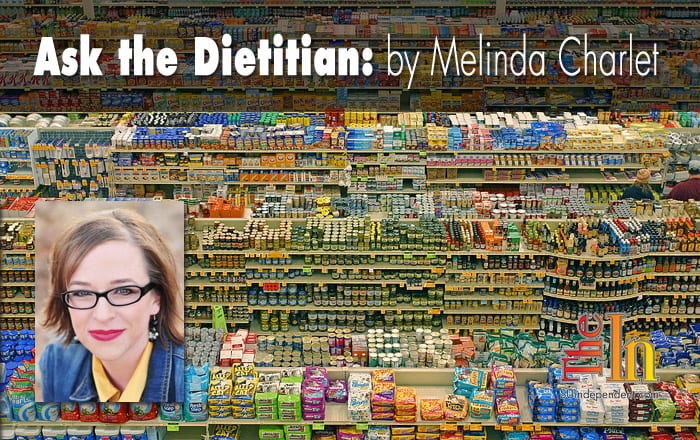 |
| Image: lyzadanger |
Dear Dietitian,
I have a friend that is always talking about ‘eating clean.’ I wash my hands before I eat, but I don’t think this is what she’s talking about. What is ‘clean eating,’ and how does one go about doing it?
Feeling Dirty
Dear Reader,
“Clean eating” has recently become a buzz word in the health arena, but it actually dates back to the 1960s. During this time, there was a natural health food movement where processed foods were shunned for moral and societal reasons. Recently, it has been reborn for health and nutrition reasons and continues to gain traction.
The basic principles encourage healthy, whole, unprocessed foods. Instead of focusing on eating more or less of specific foods or types of foods, it focuses on trying to eat foods in their most natural form. Clean eating has its pros and cons, and taking it to the extreme can be harmful, but some of its concepts can be beneficial.
First, we need to define what constitutes a “processed food.” Processing includes adding anything to a food or changing its form. Additives range from salt or sugar, to chemicals manufactured in a lab. Some of these additives are used to preserve foods and keep them from spoiling too fast. Not all additives are necessarily bad. Limiting ultra-processed foods that contain lengthy lists of ingredients you can’t pronounce is probably a good idea, but eliminating all additives is probably not necessary.
Processing also includes changing the form of the food by using heat or cold or changing the consistency of a food. Using temperature to freeze or can a food can allow you to eat something in the off-season that you otherwise would not be able to eat. Pasteurizing milk is a process that uses heat to kill bacteria that could make you sick. These forms of processing have more upsides than down. But removing the bran and germ from whole grains to create refined bread products is a form of processing that removes nutrients and should be avoided when possible.
Some forms of processing can make a food more palatable or appealing. Steaming broccoli or putting fruits and vegetables in a blender to make a smoothie are technically forms of processing, but you may end up consuming more nutrients than you would otherwise.
Here are some tips to help you clean up your diet:
Limit packaged foods
Eat fresh when you can, and try to limit foods in boxes, cans, or packages. If you are eating a packaged food, check ingredient labels and make sure they are short and recognizable. Try to avoid artificial colors and flavors.
Cook Clean
Cooking can sometimes decrease the nutritional content of food, but some nutrients can be made more available such as lycopene. Choose a cooking method that preserves as many nutrients as possible, such as steaming verses deep-fat frying.
Limit alcohol consumption
Don’t forget to “clean up” what you drink as well. Try to stay within the recommended limit of one drink per day for women and two for men. Alcohol in moderation may be good for your heart, but too much can provide excess calories and also dehydrate you. Mixed drinks can have a lot of added sugar.
Eat more fruits and vegetables
Fruits and vegetables are full of vitamins and fiber and are as clean as it gets as they need minimal processing to eat. Just make sure and wash them before consuming. Frozen versions are the next best option, if fresh is not available.
Limit Salt, Sugar, and Fat
Cutting back on processed, packaged foods will naturally reduce the salt, sugar and fat in the foods you are eating. Most American’s get too much of all three. Limit sodium to less than 2,300 mg per day. The recommended limit for sugar intake by the American Heart Association is 6 teaspoons a day for women and 9 teaspoons for men. Chose more healthy, unsaturated fats, which are found in things like olive oil, nuts, and avocados, instead of saturated fats found in animal products.
It is probably not possible—or even a good idea—to eat 100 percent clean, but trying to eat foods that are close to their natural state and with as few additives as possible is a good goal. Hopefully this explanation of clean eating has helped answer your questions and given you some ideas on how to eat a cleaner diet.
Healthy wishes,
Melinda the Dietitian
Feel free to submit your nutrition related questions and I will address them in future editions of Ask the Dietitian.
Melinda Charlet is a Registered and Licensed Dietitian that lives in St. George, Utah. She has a bachelor’s degree in Medical Dietetics and works throughout Southern Utah and Nevadahelping patients and clients achieve proper nutrition for their individual needs. She likes to create healthier versions of recipes in her free time. She assists people with a variety of conditions including diabetes and kidney disease, and counsels people that would like to lose some weight, need help dealing with cholesterol issues or simply want to live a healthier lifestyle. Send her your questions to [email protected] or connect with her on Facebook @ https://www.facebook.com/MelindaCharletRD.




